
Utricularia dichotoma, commonly known as fairy aprons, is a variable, perennial species of terrestrial bladderwort. It is a widespread species with mauve or purple fan-shaped flowers on a slender stalk and usually grows in wet locations.

Scaevola aemula, commonly known as the fairy fan-flower or common fan-flower, is a species of flowering plant in the family Goodeniaceae. It has mostly egg-shaped leaves and blue, mauve or white fan-shaped flowers. It grows in New South Wales, South Australia, Victoria and Western Australia.

Lobelia purpurascens, commonly known as white root or purplish pratia, is a flowering plant in the family Campanulaceae of eastern Australia. It is a small herbaceous, scrambling plant with white to pale pink flowers.
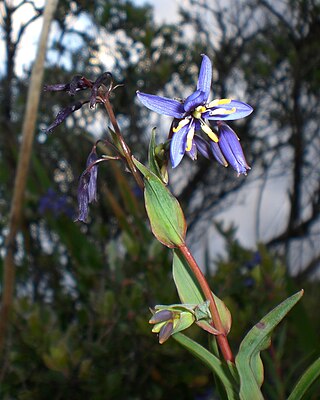
Stypandra glauca, commonly known as the nodding blue lily, is a flowering plant in the family Asphodelaceae. It is a rhizomatous perennial plant with blue lily-like flowers with yellow stamens. It is widespread across southern areas of Australia.

Pterocaulon sphacelatum, commonly known as apple bush or fruit-salad plant, is a species of flowering plant in the family Asteraceae. It is an upright shrub with mostly pink to purple flowers and is endemic to Australia.
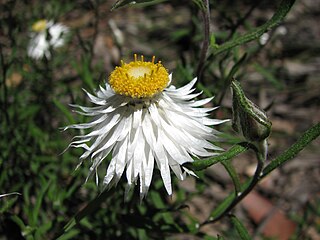
Helichrysum leucopsideum, commonly known as satin everlasting, is a flowering, perennial herb in the family Asteraceae. It is grows in all states of Australia except Queensland and the Northern Territory. It has white, terminal flower heads and narrow, woolly leaves.
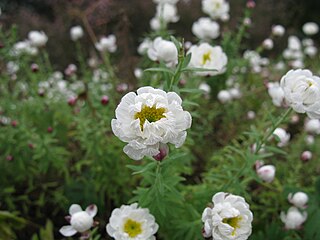
Rhodanthe anthemoides, commonly known as chamomile sunray, is a flowering plant in the family Asteraceae. It is a small, perennial shrub with greyish-green leaves, white papery flowers, yellow centre and is endemic to Australia.
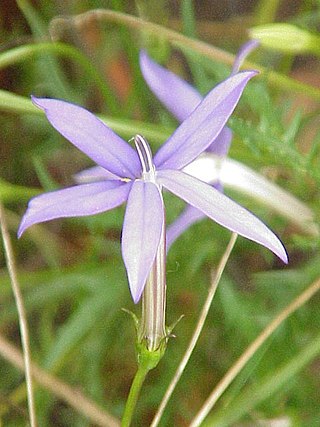
Isotoma axillaris, commonly known as rock isotome or showy isotome, is a small herbaceous perennial in the family Campanulaceae. It usually has blue or mauve star-shaped flowers from September to May. It may also be called blue star, star flower, or laurentia.
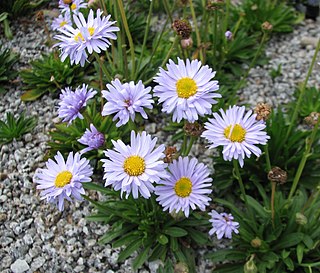
Brachyscome scapigera commonly known as tufted daisy,is a flowering, perennial herb in the family Asteraceae. It has white or mauve daisy-like flowers and is endemic to south-eastern Australia.

Brachyscome graminea, commonly known as grass daisy, is a perennial herb in the family Asteraceae and is endemic to Australia. It has mostly mauve-pink or purple daisy-like flowers and a yellow centre.

Brachyscome dentata, commonly known as lobe-seed daisy, is a tufted perennial herb in the family Asteraceae and is endemic to Australia. It has mostly white or mauve daisy-like flowers, a yellow centre and pale green leaves. It is endemic to Australia.

Calotis cuneifolia commonly known as purple burr-daisy, is a flowering plant in the family Asteraceae found in many parts of eastern and central Australia. It has purple, white or blue daisy-like flowers with variable shaped leaves.

Calotis dentex commonly known as white burr-daisy, is a flowering plant in the family Asteraceae. It is a small shrub with white daisy like flowers and grows in New South Wales and Queensland.

Scaevola depauperata, commonly known as skeleton fan-flower, is a species of flowering plant in the family Goodeniaceae. It is a small understorey shrub with blue, mauve or cream-white flowers. It grows in mainland states of Australia with the exception of Western Australia.

Minuria leptophylla commonly known as minnie daisy, is a flowering plant in the family Asteraceae. It is a small perennial herb with white daisy-like flowers. It is endemic to Australia and grows in all mainland states.
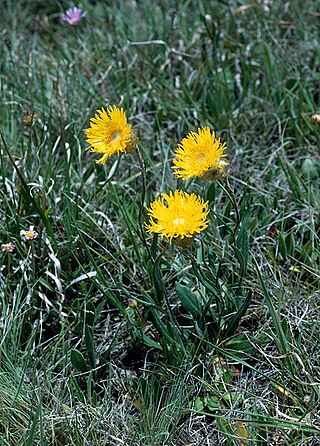
Podolepis decipiens, commonly known as deceiving copperwire-daisy, is a flowering plant in the family Asteraceae and grows in Victoria, Tasmania and New South Wales. It is an upright, perennial herb with yellow daisy-like flowers on a single stem rising from a sparse rosette.

Comesperma retusum, commonly known as milkwort, is a slender herb in the family Polygalaceae. It is an upright shrub with purple or mauve-pink pea-like flowers and grows in eastern Australia.
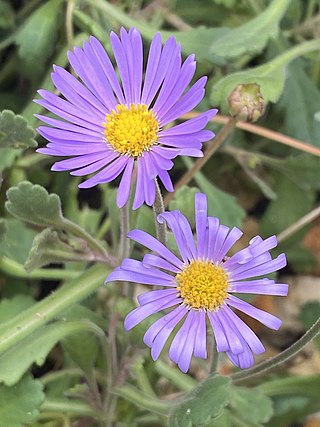
Brachyscome microcarpa, commonly known as forest daisy, is a perennial herb in the family Asteraceae and is endemic to Australia. It has mostly white or mauve daisy-like flowers, a yellow centre, variable shaped leaves and flowers from October to January.

Brachyscome dissectifolia commonly known as swamp daisy, is a flowering perennial herb in the family Asteraceae. It is a prostrate plant with slender stolon stems, mauve or white flowers and is endemic to New South Wales.

Leucochrysum graminifolium, commonly known as pagoda rock daisy, is a flowering plant in the family Asteraceae. It is a small perennial with narrow leaves, yellow flower-heads and is endemic to New South Wales.




















